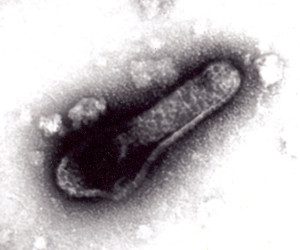

The Advisory Committee on Immunization Practices (ACIP) voted today, 13 to 0, in favor of recommending FluBlok during the 2013-2014 influenza season for vaccination of persons 18 through 49 years of age with egg allergy of any severity.
FluBlok is an influenza virus vaccine that is produced by expressing the influenza virus hemagglutinin (HA) protein in insect cells using a baculovirus vector. Baculoviruses are rod-shaped viruses (see photograph) that infect insects and other arthropods. The baculovirus virion contains a double-stranded DNA genome. To express the influenza virus HA proteins, recombinant baculoviruses are produced in which DNA encoding the HA protein is inserted into the baculovirus DNA genome. When insect cells are infected with the recombinant baculoviruses, the influenza HA protein is produced.
To manufacture FluBlok, three recombinant baculoviruses were isolated that contain the HA gene from A/Panama/2007/99 (H3N2), A/New Caledonia/20/99 (H1N1), and B/Hong Kong/330/2001. After infection of insect cells with these recombinant baculoviruses, the HA proteins were purified to greater than 95% purity. In a randomized, placebo-controlled clinical trial, FluBlok was shown to be 44.6% effective in preventing culture-confirmed influenza. The low efficacy might in part be due to antigenic mismatch between the HA proteins used in the vaccine and circulating viruses.
Because FluBlok is not produced in eggs it may be used in individuals with egg allergies. Another alternative for such individuals is Flucelvax, an influenza vaccine produced in cell culture, which was approved by the Food and Drug Administration in November 2012.

What is your comment about the poor immunogenicity of FluBlok among young children?
According to JC King et al. Vaccine 2009;27:6589-94, “poor response rates to FluBlok observed in the 6–35-month-old age group are unexpected and remain largely
unexplained. One possibility may be the known differences between FluBlok and conventional egg-derived vaccines in the glycosylation and cleavage of the HA molecule, which could result in differences in antigenicity and efficient presentation to the immune system in young children. HA produced in insect cells is generally less heavily glycosylated than HAs produced in chicken cells, and, more specifically, it has been reported that the complex oligosaccharides found on HAs derived from vertebrate hosts are replaced by small truncated side chains on HAs derived from insect cells. In addition, while HA produced in insect cells remains mostly in an “uncleaved†form, the HA present in TIV is primarily in the form of the cleaved HA1 and HA2 fractions”.